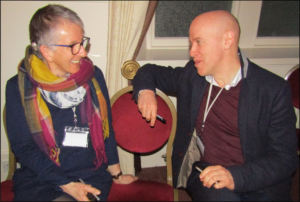
A ground-breaking initiative is helping to address the longstanding problem of recruiting and retaining GPs in some of Scotland’s more isolated communities.
And it’s proving so successful that it may be expanded to other parts of the country.
In a pioneering project involving four health boards in the north of the country, no fewer than 26 doctors have been recruited to work for 12 to 18 weeks a year in practices that have found it difficult to attract GPs.
The recruitment and retention of general practitioners is a perennial problem throughout the country but it brings particular challenges in Scotland’s remote and rural communities.
In the new initiative, called Rediscover the Joy of General Practice – The Joy for short – a large rural support team of GPs has been recruited to work for short periods in the areas covered by NHS Highland, Western Isles, Orkney and Shetland.
Governance and evaluation of the project is the responsibility of the Scottish Rural Medicine Collaborative (SRMC), which was set up with Scottish Government funding to develop and test innovative ways of improving GP recruitment and retention in 10 health board areas.
Ralph Roberts, the SRMC’s senior responsible officer and Chief Executive of NHS Borders, said that although The Joy was still in its infancy, it was one way of helping to improve recruitment to some of the country’s more isolated communities.
He said: “For a variety of reasons many rural practices have found it difficult to attract and keep doctors. Working in remote and rural areas isn’t necessarily for everybody but The Joy is undoubtedly making it a much more attractive preposition.”
The scheme was designed to appeal in particular to doctors who had either recently retired or planned to do so, but were nevertheless keen to try new and challenging work in some of Scotland’s most beautiful areas. The ‘Joy’ GPs do not need to relocate permanently and they have flexible work patterns with the opportunity to work in different practices if they want.
They are attached to a rural practice for one to four weeks at a time and are asked to provide two weeks a year of short-notice cover, generally to support single-handed practices at times of sickness or when compassionate leave is required.
Although the ‘Joy’ GPs are separated geographically, they are very much a team. They hold regular video-conferencing meetings to discuss quality improvement, interesting cases and so on, and have their own social media messaging group, sharing work and personal experiences with each other.
Martine Scott, the SMRC’s programme manager, said The Joy was proving so successful that consideration was being given to extending it both by recruiting another cohort of GPs and by applying it to other parts of Scotland.
She said: “There can be no single solution to the problem of GP recruitment and retention in Scotland’s remote and rural communities, which is why the SRMC has been developing a range of projects. For instance, we have been working on a dedicated GP recruitment website for Scotland www.GPjobs.scot, which is proving increasingly valuable, and we have a presence at key events and conferences, ‘selling’ rural practice to GPs who may not have considered it as a career option.”
With colleagues she will be showcasing The Joy and the work of the SRMC at the Royal College of General Practitioners’ annual primary care conference and exhibition, to be held in Liverpool from 24-26 October.
She added: “Because of recruitment issues, some GP practices in remote and rural Scotland have closed, some have had to merge, and many have had to use locum doctors, which is expensive and does not lend itself to continuity of care.
“However, through The Joy we now have a highly-motivated team of very experienced GPs who are helping boards and practices to fill gaps that would have been hard to fill. The Joy is working well in the four board areas it covers and we are in talks about how the scheme might be applied elsewhere in Scotland.”
The Joy is the brainchild of Orkney GP Dr Charlie Siderfin, a medical advisor to the Scottish Government and a member of the SRMC board.
He said: “We advertised for GPs through the BMJ Journal and the response was excellent, I think in part because GPs see this as a collaborative and systematic effort to address recruitment and retention issues rather than a sticking-plaster approach.”
One of the doctors recruited through the initiative is Shropshire GP Dr Helen Willows, who has been used to plug gaps in Scalloway and Brae in Shetland and in Stornoway in the Western Isles.
She continues to work as a locum GP in her home area but she welcomes the challenge The Joy is giving her.
She said: “I started working in medicine relatively late in life, when I was in my 30s, and at 62 I feel I have plenty energy to take on something different. The Joy is certainly that. It’s pretty full-on work but I’m able to practise as what I would call an old-fashioned GP. I can think creatively and independently and I don’t have to involve myself in much of the bureaucracy that can be involved in general practice.”
She added that her husband, a retired engineer, was able to join her while she worked in Scotland.
“We’re enjoying our time here and I would envisage doing this for another few years,” she said.
Another Joy recruit is Dr Peter Glennon, also aged 62, who recently retired from general practice in Stafford.
He said: “I could have carried on working as a locum in Stafford but I was drawn to the challenge of The Joy. I still have plenty drive and energy, and that’s certainly needed with this work.”
Dr Glennon’s work as a member of the ‘Joy’ team has taken him to Wick, where he did a four-week stint, and he is lined up to practise over the winter in Acharacle in Lochaber, Stornoway and Carbost on Skye.
“It can be challenging,” he said. “Working in remote locations, you need to be a super-generalist and be able to deal with just about anything. I understand that some GPs may be apprehensive about working in communities far away from big hospitals, for example, but that’s part of the appeal for me.
“What’s more, it’s nice to work as a salaried GP. It’s refreshing to have just clinical work to do, without the bureaucracy involved in being a partner in a practice.”
